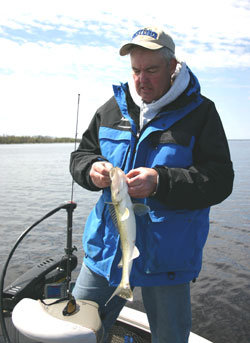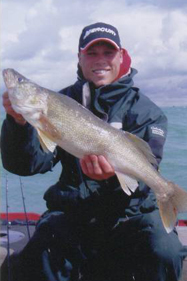 There’s something extremely satisfying about catching walleyes and it‘s not just how good they taste, and it can‘t be how hard they fight. Maybe it’s those crazy eyes. Maybe it’s the challenge and satisfaction of outwitting a fish that can play so darn hard to get. Whatever it is; there’s a few things anglers can to do to help up there odds of meeting their date with early season destiny.
There’s something extremely satisfying about catching walleyes and it‘s not just how good they taste, and it can‘t be how hard they fight. Maybe it’s those crazy eyes. Maybe it’s the challenge and satisfaction of outwitting a fish that can play so darn hard to get. Whatever it is; there’s a few things anglers can to do to help up there odds of meeting their date with early season destiny.
Professional fisherman and Team Crestliner member Danny Plautz of Muskego, Wisconsin has spent years tracking down and catching up with ‘ol marble eyes and offers some hard earned advice; " Given an option I’ll head for a river early in the season, they warm up faster and the fish are usually a lot more active.
One of my favorite early season river tactics involves using a three-way rig that has a short six inch dropper tied to a big 1ounce jig tipped with a fathead, and a three foot leader tied to a shallow running minnow imitating bait like the Reef Runner Little Ripper. The big jig won’t catch many fish but the ones you do hook up with usually run big! I’ll slowly troll the three-way rig upstream along the edges of current breaks and lift and drop the jig and let it thump hard. That thump can attract fish and when they zero in on it they’ll either grab the jig or scarf up the crank bait. Getting the speed right is important and you should be in the range if you’re line is running at about a forty-five degree angle.
Another thing I’ll do with the three-way rig is replace the crank bait with a floating jig head, especially if things are a little tough, and it’s a great way to deal with a lot of pressure. When too many anglers converge on a spot you can still catch fish by moving outside of them and slowly trolling the heavy jig and floating jig head combination. "
If you’re plans include a hot walleye lake then so be it. Just keep in mind the fact that things can change from one year to the next, so keep an open mind. Plautz on lakes; " One of the first things I look for is weed growth along the north end of a lake. The north end typically warms up faster because the winds early in the season are predominantly out of the south which piles up warmer surface water on the opposite end.
The temps might vary only a few degrees but that can make a big difference on just how active the walleyes will be. I’ll look for weed beds as shallow as two to five feet and they can hold plenty of walleyes and should not be overlooked. A great way to work the beds over is to pitch a light jig tipped with a plastic grub tail. You can tip it with a minnow but you usually don‘t have to. If you’re not finding fish up shallow don’t be afraid to move deeper, especially if there’s deeper growing weeds like sandgrass. Sandgrass will grow maybe six inches off the bottom and walleyes will hunker down in it and wait something to swim by.
 To work the sandgrass I’ll back up and drop the anchor and throw out a slip bobber and leech and set it to run eight inches or so off the bottom." Plautz likes to use super braids like Fireline for his slip bobber rigs but will tie in a three or four foot piece of Vanish fluorocarbon as a leader.
To work the sandgrass I’ll back up and drop the anchor and throw out a slip bobber and leech and set it to run eight inches or so off the bottom." Plautz likes to use super braids like Fireline for his slip bobber rigs but will tie in a three or four foot piece of Vanish fluorocarbon as a leader.
Light 1/16 ounce jigs like Northland Tackle’s new Slurpies Swim’n Grub are perfect pitching baits and can be red hot even in the colder water temps of the early season. Slurpies are available in some incredible colors and are loaded up with SowSauce which is a powerful scent attractor.
Another weed technique Danny will use is simple one and consists of a split shot and a plain hook tipped with a redtail chub. He’ll cast it out and work it back painfully slow, just a few inches a time, and give the bait plenty of time to get noticed and picked up. "Here in Wisconsin I can fish with more than one line and will cast out the rig and let it set while I pitch and work the jig. I’ll pick up the split shot rig every so often to see if anything has picked it up and move it just a bit before setting the rod back down again."
Rocks are another early season key and is where Danny finds larger fish; "You can catch plenty of smaller males along the weedline and you will run into larger fish occasionally, but the real numbers of big mamas are on the rocks. Shallower rocky reefs can hold some big fish early in the season but unless you have a lot of wind you’ll probably have to stay up late if you plan on getting in on the action. That means sticking with the program until way after sundown, and especially the period between midnight and four in the morning."
Good night run tactics include anchoring up and using slip bobbers and leeches, or trolling deeper running crank baits. What method you choose should depend on what exactly is available with smaller bars and rock piles more effectively fished with the anchoring technique, and trolling cranks more applicable to covering longer and more expansive stretches. See you on the water.










